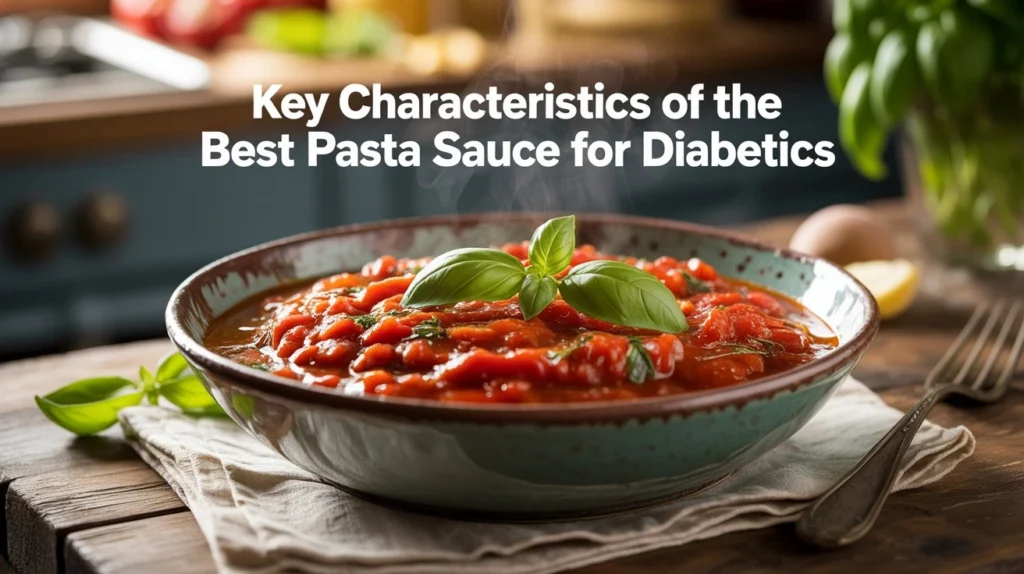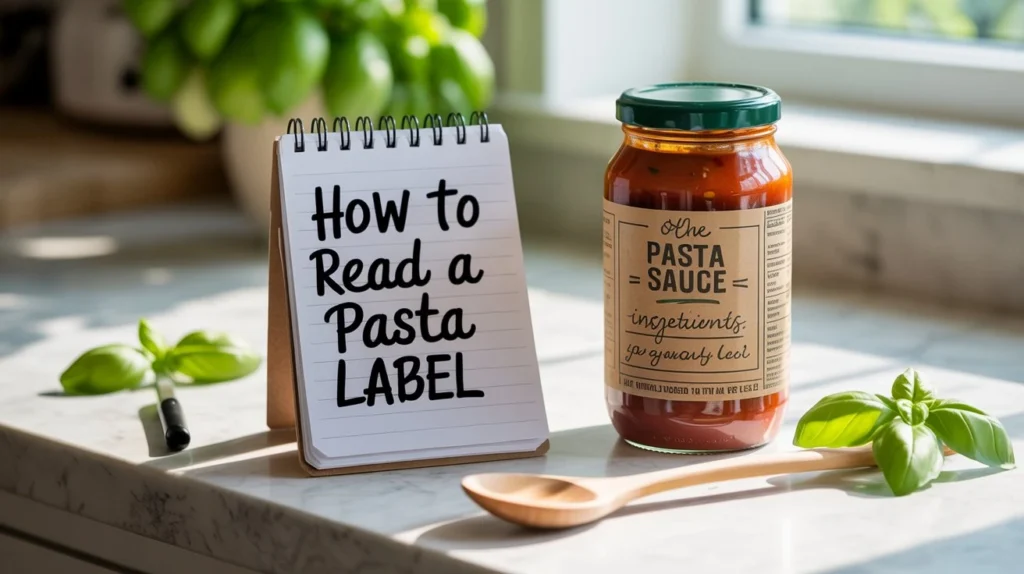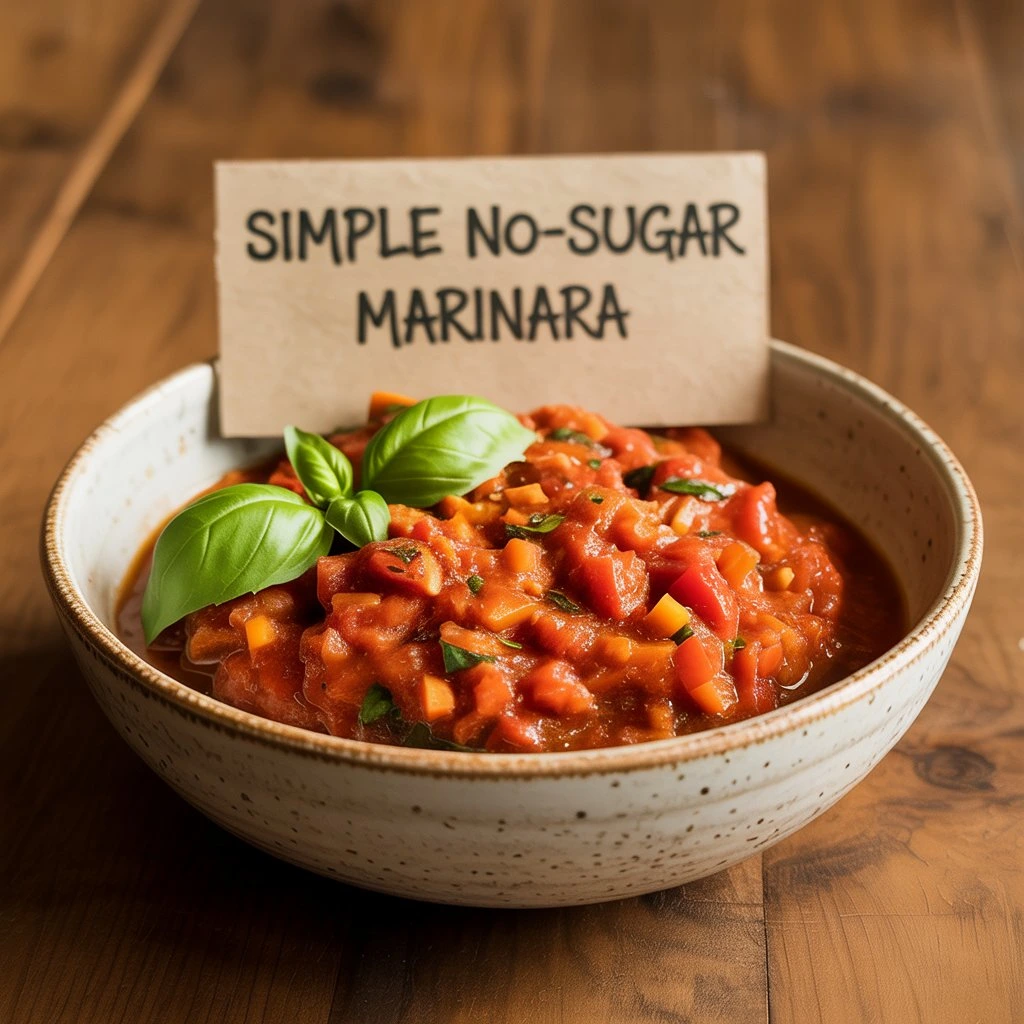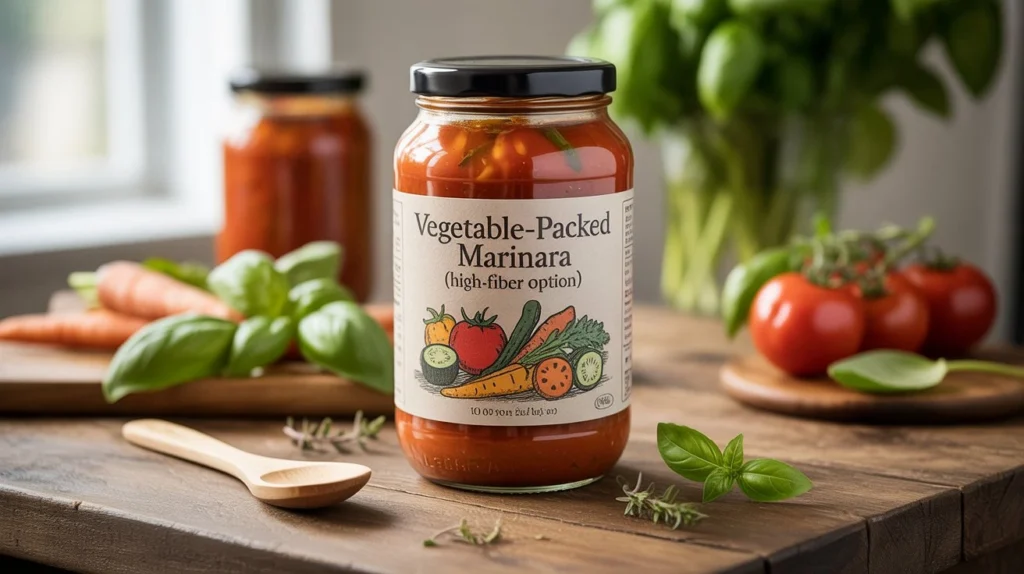
Best Pasta Sauce for Diabetics means a sauce that is low in added sugar, moderate in carbohydrates, higher in fiber, and paired with healthy fats and protein to reduce blood-glucose spikes. Choosing the right sauce helps you enjoy pasta without compromising blood sugar control.
That’s why the best options include simple tomato-based marinara made from no-sugar-added crushed tomatoes, vegetable-packed marinara, light olive oil & garlic sauces, and lean-protein tomato sauces. These give you flavor and satisfaction with minimal sugar and a nutrient profile that supports diabetic-friendly eating.
In this article I’ll show you exactly how to make three practical, tested sauces step-by-step (including ingredient amounts and timings), how to read labels when buying jars, portioning and pairing strategies, storage and reheating instructions, and common troubleshooting. You’ll also get small personal tips I use at home so the sauce tastes great without sugar or excess calories.
Why sauce choice matters for people with diabetes
Many people think only pasta matters; but sauces are often the hidden variable. A jar of commercial pasta sauce can contain several grams of added sugar per serving — enough to nudge blood glucose upward when paired with pasta.
Reading labels is essential because manufacturers sometimes add sugar to balance acidity. A good rule is: prefer sauces that are sugar-free or clearly state “no added sugar.”
Also, carbohydrate portioning and the presence of fiber and protein strongly affect blood glucose response. The American Diabetes Association recommends choosing carbohydrate sources that are nutrient-dense (higher fiber, lower added sugars) and counting carbs or using the Plate Method to portion starchy foods.
Finally, national health guidance (NHS, CDC) encourages wholegrain choices, vegetables, and watching portion sizes to keep blood sugar steady — advice that directly applies to how you choose and use Pasta sauces.
Key characteristics of the best pasta sauce for diabetics

When evaluating sauces, look for these features — I’ll show how to check each in detail later:
- No or minimal added sugar (check ingredient list and “added sugars” on the label).
- Moderate total carbs and some fiber — vegetable content helps.
- Healthy fats (olive oil) rather than saturated fats (butter, cream) — a healthier alternative to heavy cream.
- Low to moderate sodium (unless your diet requires more sodium control).
- Contains or pairs well with lean protein (chicken, turkey, beans) to slow carb absorption.
These elements turn pasta into a balanced meal that supports a balanced diet and stable dietary energy usage.
Before you cook — shopping, tools, and prep timeline
Shop list (for all recipes below)
- Canned crushed tomatoes (no added sugar) — 2 × 28 oz cans
- Tomato paste (no sugar) — 1 small tube or can
- Fresh tomatoes (optional) — 4–6 ripe tomatoes
- Extra virgin olive oil — 1 bottle
- Garlic — 8 cloves
- Yellow onion — 2 medium
- Zucchini, bell pepper, spinach (for veg marinara)
- Fresh basil, oregano, parsley
- Lean ground turkey or chicken (optional) — 1 lb
- Plain Greek yogurt (for creamy light option) — 1 cup
- Whole wheat or legume pasta (your choice)
Tools
- Large sauté pan + pot for pasta
- Wooden spoon, chef’s knife, cutting board
- Blender or immersion blender (for smooth sauces)
- Measuring cups & spoons, small bowl for mise en place
Prep timeline (simple)
- 10–15 minutes: Chop vegetables and measure ingredients (mise en place).
- 20–45 minutes: Cook sauce (timing varies by recipe).
- 10–12 minutes: Cook pasta while sauce simmers or rests.
(If you roast tomatoes first, add 15–20 minutes.)
Mise en place makes everything run smoothly — I always prep first; it stops me from overcooking garlic or rushing through steps.
How to read a pasta sauce label (step-by-step)

If you buy jarred sauce, do this before you place it in your cart:
- Check “added sugars” on the Nutrition Facts panel. Anything over 4 g per ½ cup is worth a second look. Many jars list 6–10 g per ½ cup. Eat This Not That+1
- Look at the Ingredient List. If sugar, corn syrup, fructose, dextrose, concentrated fruit juice, or cane sugar appear near the top, skip it.
- Scan the sodium. Many sauces have 300–400 mg per ½ cup; choose lower sodium options if you need blood pressure control.
- Check total carbohydrate and fiber. More fiber per serving is helpful (aim for 2 g+ per serving).
- Look for “no added sugar” or “unsweetened” claims and verify they’re true via the nutrition panel.
If a jar is borderline, you can always use half the jar and stretch flavor by adding fresh tomatoes, roasted vegetables, or herbs — a practical trick I use to lower the sugar per serving and add fiber.
Recipe 1: Simple No-Sugar Marinara (Diabetic-friendly) — step by step

This is my go-to sugar-free condiment when I want classic tomato flavor without added sugars.
Ingredients (4–6 servings)
- 2 tbsp extra virgin olive oil
- 1 medium onion, finely chopped (about 1 cup)
- 4 garlic cloves, minced
- 2 × 28 oz cans crushed tomatoes (no added sugar) or 2 lb fresh, peeled & chopped tomatoes
- 1 tbsp tomato paste (no sugar)
- 1 tsp dried oregano, 1 tsp dried basil (or handful fresh basil)
- Salt & black pepper to taste
- Optional: 1 small zucchini grated (adds fiber & sweetness)
Exact steps
- Heat oil: Warm 2 tbsp olive oil in a large skillet over medium heat (about 3–4 mins until shimmering).
- Sauté onion: Add onion and a pinch of salt; cook 6–8 minutes until translucent and slightly golden — this builds sweet aroma without sugar.
- Add garlic: Stir in minced garlic; cook 30–45 seconds until fragrant (don’t brown).
- Bloom the paste: Add 1 tbsp tomato paste; stir and fry for 1–2 minutes — this deepens tomato flavor.
- Add tomatoes: Pour crushed tomatoes (or cooked fresh tomatoes), add zucchini if using, stir.
- Season & simmer: Add herbs, salt, and pepper. Bring to a gentle simmer, then reduce heat to low and simmer uncovered for 20–30 minutes, stirring occasionally to prevent sticking.
- Finish & taste: If sauce tastes too acidic, add a teaspoon of balsamic vinegar (small amount), or a pinch of grated carrot for natural sweetness (no added sugar). Adjust salt. Remove from heat and stir in torn basil.
Why this works: The simmer time softens tomatoes and brings out natural sweetness without added sugar. The grated zucchini adds fiber and a mild, natural sweetness so you don’t miss sugar.
Personal note: I roast half the tomatoes under high heat for 20 minutes sometimes — the roasted flavor gives a caramelized note so I never have to add sugar.
Recipe 2: Vegetable-Packed Marinara (High-fiber option)

This sauce turns your plate into a healthier alternative by adding non-starchy vegetables for fiber and volume.
Ingredients (4–6 servings)
- 2 tbsp olive oil
- 1 large onion, 2 carrots, 2 celery stalks (finely diced) — classic soffritto base
- 2 cloves garlic
- 1 red bell pepper, diced
- 2 cups chopped mushrooms (optional)
- 2 cans (28 oz) crushed tomatoes (no added sugar)
- 2 cups spinach (stir in at end)
- Herbs: oregano, thyme, bay leaf
- Salt & pepper
Steps
- Sauté veg base: Heat oil, add onion/carrot/celery, cook 8–10 minutes until soft.
- Add bell pepper & mushrooms: Cook for 4–5 minutes.
- Add garlic & tomatoes: Add garlic briefly, then add crushed tomatoes and herbs.
- Simmer 25–40 minutes: Let flavors meld. Add spinach last 2–3 minutes so it wilts but retains nutrients.
- Blend (optional): For a smooth sauce, blend half or all of the sauce. Leaving chunks increases texture and satiety.
This sauce is naturally higher in fiber and lower in net carbs per serving because vegetables displace some tomato volume. Fiber helps blunt blood sugar rises and increases fullness. (See ADA guidance on choosing fiber-rich carbs.) American Diabetes Association
Recipe 3 — Light Creamy “Greek-Style” Sauce (Diabetic-friendly creamy option)

If you miss creamy sauces, try this light version using Greek yogurt — a smart swap for heavy cream.
Ingredients (4 servings)
- 1 tbsp olive oil
- 1 small onion, chopped
- 1 clove garlic, minced
- 1 cup plain Greek yogurt (0% or 2% fat)
- ¼ cup low-fat grated Parmesan
- Zest of half a lemon
- Salt & pepper to taste
- Optional: 1 cup cooked, shredded chicken for protein
Steps (important: temperature control)
- Sauté aromatics: Heat oil, cook onion until soft, add garlic 30 seconds. Remove the pan from the heat.
- Cool slightly: Let the pan cool for 1–2 minutes (very important — high heat will curdle yogurt).
- Temper yogurt: Whisk yogurt with a few spoonfuls of warm cooking liquid (broth) to temper it. Slowly stir yogurt mixture into pan off the heat.
- Warm gently: Place on the lowest heat and stir until just warm (do not boil).
- Add cheese & lemon: Stir in Parmesan and lemon zest for bright flavor.
Why this works: Greek yogurt adds protein and creaminess with far fewer calories than cream. Tempering prevents curdling. Pairing with whole-grain pasta or zoodles keeps carb load lower.
Portion control & pasta pairing — exact guidance
The sauce choice is only half the picture. Portioning and pasta type matter.
- Pasta serving: Aim for about 1 cup cooked pasta (~140–160 g cooked) as a starting portion. If you follow carbohydrate counting, that’s often ~30 g carbs depending on pasta type — check package. The CDC and ADA recommend portion control or using the Plate Method (1/4 plate starchy foods).
- Better pasta choices: whole wheat, legume (chickpea, lentil) pasta, or spiralized zucchini (zoodles) lower glycemic impact.
- Plate composition: 1/2 non-starchy veggies + 1/4 lean protein + 1/4 whole-grain pasta is a practical lifestyle choice that balances dietary energy needs and helps with blood sugar control.
Personal tip: I mix half whole-grain pasta and half zucchini ribbons when serving guests — they like the texture, and my plate has more fiber without a strong taste difference.
Store-bought sauce: pick, stretch, and fix
If you must buy sauce, here’s an action plan:
- Pick “no added sugar” jars and verify using nutrition facts. Many decent options have 0–2 g added sugar per serving.
- Stretch and improve: Dilute jarred sauce with canned crushed tomatoes (no sugar), add sautéed veg, or blend in fresh spinach. This lowers sugar per serving and boosts fiber.
- Use as condiment, not main filler: A shorter rule of thumb — treat sauce as a sugar-free condiment and build the meal around veggies and protein.
Storage, make-ahead, and reheating (step-by-step)
- Cool quickly: After cooking, cool sauce 20–30 minutes at room temp, then refrigerate.
- Fridge: Use within 4–5 days for tomato-based sauces.
- Freezer: Freeze in portions for 2–3 months — label with date. Defrost in the fridge overnight.
- Reheat: Warm slowly on medium-low, stirring, adding a splash of water or stock if too thick. For cream sauce, add a little extra yogurt/stock while warming to avoid separation.
Troubleshooting common problems (and fixes)
- Too acidic: Stir in a teaspoon balsamic or a small grated carrot; cook 5–10 more minutes.
- Too thin: Simmer uncovered for 10–20 minutes; or blend some vegetables in to thicken.
- Too salty: Add cooked potato chunks while simmering for 10 minutes, then remove (they absorb salt), or dilute with unsalted crushed tomatoes.
- Sauce bland: Add fresh herbs at the end, a squeeze of lemon, or a teaspoon of umami (mushrooms or a few drops of Worcestershire if acceptable).
Nutrition, blood-sugar impact & calorie ideas
A typical 1/2 cup serving of homemade no-sugar marinara: ~50–80 kcal, 6–10 g carbs, 2+ g fiber. Pair this with 1 cup cooked whole-grain pasta (~35–40 g carbs) and 3–4 oz lean protein to make a balanced meal.
Remember: “high in carbohydrates” foods like regular white pasta increase post-meal glucose more than whole-grain or legume pasta — choose wisely. Using legume pasta increases protein and fiber, lowering glycemic response in many people.
If your plan includes weight loss or calorie restriction, focus on portion size, pick lower-calorie bases (zoodles/pumpkin/pasta made from legumes), and load sauce with non-starchy vegetables to increase volume without excessive calories.
Final practical meal plan ideas (3 quick examples)
- Weeknight bowl (simple): 1 cup whole-grain spaghetti + ½ cup vegetable marinara + 3 oz grilled chicken + side salad (leafy greens).
- Light weekend: 1½ cups zoodles + ½ cup no-sugar marinara + 2 tbsp pesto + 2 tbsp grated Parmesan.
- Comfort swap: 1 cup chickpea pasta + ½ cup light creamy Greek yogurt sauce + roasted mushrooms + spinach.
FAQs About Best Pasta Sauce for Diabetics
Can diabetics eat pasta sauce?
Yes — if it’s low in added sugar and paired with balanced portions.
Is marinara better than creamy sauces?
Marinara typically has fewer calories; creamy sauces can be adapted (Greek yogurt swap).
How to sweeten without sugar?
Roast tomatoes, simmer carrots, or add a splash of balsamic for perceived sweetness.
Are jarred sauces always bad?
No — read labels and choose no added sugar options or stretch them with veggies.
Closing thoughts
Choosing the Best Pasta Sauce for Diabetics is not about deprivation; it’s a practical way to enjoy pasta as Not guilty food — food you can love without compromising health. Small cooking techniques (roasting tomatoes, adding grated vegetables, tempering yogurt) give you a healthier alternative to sugary jars or heavy cream, turning your plate into a balanced meal that supports stable blood sugar and sustainable eating.
From my experience, the two biggest wins are: (1) make a large batch of vegetable-rich marinara to use all week (freezer portions are lifesavers), and (2) pair every pasta portion with protein and extra vegetables. These simple habits make pasta compatible with a diabetic meal plan and help with weight loss, satiety, and long-term control of dietary energy.
